Sri Lanka
![]()
Ceylon is a redirect to this article. For other meanings, see Ceylon (disambiguation).
6.91666666780Coordinates: 7° N, 80° E
Template:Infobox State/Maintenance/TRANSCRIPTION
Template:Infobox State/Maintenance/NAME-German
Sri Lanka (Sinhala ශ්රී ලංකා, śrī laṃkā, [ˌɕriːˈlaŋkaː]; Tamil இலங்கை, ilaṅkai), until 1972 Ceylon (since then the Democratic Socialist Republic of Sri Lanka), is an island nation in the Indian Ocean, 237 km (9 mi) (west coast of the island) east of the southern tip of the Indian subcontinent, and has a population of 21.9 million. The shortest distance between India (Kodiyakkarai) and Sri Lanka (Munasal) is 54.8 km.
Due to its location, the island formed a strategic junction for maritime travel between the Near East and Southeast Asia from ancient to modern times. The south and the areas around Anuradhapura were centers of ancient Buddhism, whereas Hindu temple complexes existed in the north and east. Today, the country is a multi-religious and multi-ethnic nation where Christianity and Islam are major religions along with Buddhism and Hinduism. The Sinhalese make up the majority of the population. The Tamils constitute the largest minority. Other ethnic minorities include the Moors, Malays, Burghers and Sri Lanka's indigenous population, the Veddas.
Sri Lanka is known for the production and export of tea (Ceylon), coffee, rubber and coconuts. The island is a popular tourist destination due to its scenic beauty and rich cultural heritage (for example, Ayurveda, a traditional healing art).
Sri Lanka was ruled by various local kingdoms for over two millennia until large parts of the island were colonized by the Portuguese and then the Dutch in the 16th century. Only the kingdom of Kandy in the highlands of the island was able to hold its own against the colonizers. In 1815, however, the whole country finally became part of the British Empire. During the Second World War, Sri Lanka served the Allies as a strategically important base in the fight against the Japanese Empire. From the beginning of the 20th century, there were increasingly strong efforts for independence. In 1948, after peaceful negotiations, Sri Lanka became independent from the British. In contrast to most states of the so-called "Third World", a stable, democratic system has existed since independence, although it was and still is burdened by the antagonisms between the Sinhalese majority and the Tamil minority. Between 1983 and 2009, open civil war raged in Sri Lanka between Tamil separatists and the Sinhalese-dominated central government, resulting in numerous deaths, mostly among the civilian population. The human rights crimes of the civil war have not been independently addressed to date. Between 2005 and 2015, Mahinda Rajapaksa was the country's president and ruled the country with an authoritarian gesture. From January 2015 to November 2019, Maithripala Sirisena was the president who promised a shift away from authoritarianism. After that, Gotabaya Rajapaksa, Mahinda's brother, was elected president. Mahinda became the head of the government.
Geography
Primeval
In prehistoric times, the Indian subcontinent was much larger in area than it is today; at that time Sri Lanka was connected to India. The land masses were probably separated between 6000 and 3500 BC. The "Adam's Bridge" (a group of islands between Talaimannar and Rameswaram in India) is the last visible trace of this connection.
Geographical position
Sri Lanka is located in the Indian Ocean, southeast of the Indian subcontinent, between 6° and 10° north latitude and between 79° and 82° east longitude. It measures about 445 kilometres in north-south and 225 kilometres in east-west. It is separated from India (state of Tamil Nadu) by the Palk Strait and the Gulf of Mannar. The coral rock islands of the Adam's Bridge provide a loose link between northwestern Sri Lanka and mainland India. According to reports from the British colonial period, this natural causeway was almost complete, but was destroyed by a strong storm in 1480. The Palk Strait is so narrow that one can see the coast of Sri Lanka from Rameswaram. The southern tip of the island is Dondra Head.
Sri Lanka can be divided into three different landscapes: central highlands with the famous tea growing areas and mountains up to 2500 m high, lowland plains which were made fertile centuries ago by artificial irrigation and the coastal area with fishing and palm beaches.
The central highlands in south-central Sri Lanka are the heart of the country. In the core of the highlands lies a high plateau 65 kilometers long in a north-south direction. The highest elevation of the country is the Pidurutalagala with 2524 m above sea level. Two mountain ranges extend from the southern end of the plateau, one 50 kilometres to the east to Namunakula (2036 m) and one 50 kilometres to the west to Sri Pada (2243 m). Sri Pada is the most important mountain for various religions. To the west and east, the center of the highlands is bordered by two plateaus; to the north and south are other mountains, each separated from the center by valleys. The 240 meter high Bambarakanda waterfalls are the highest waterfalls in Sri Lanka.
Most of the island consists of large tropical plains, 30 to 200 meters above sea level. In the southwest, mountain ridges and valleys slowly merge into the central highlands. In the southeast, laterite-covered plains and hills are found. The transition from the plains to the central highlands is abrupt, making the mountains look like a wall. The plain to the north and east is flat and dissected by narrow granite ridges towards the highlands.
The island is enclosed by a coastal belt 30 meters above sea level. The coasts of Sri Lanka consist mostly of sandy beaches.
Geology
More than 85 percent of Sri Lanka's surface lies on a Precambrian layer, some of which is over two billion years old. The metamorphic rock surface was formed by the transformation of very old sediments. Plate tectonics theory suggests that these rock massifs, which form most of the Indian subcontinent, belonged to Gondwana. 200 million years ago, the Indian subcontinent separated from Gondwana and headed towards the Asian plate. After India collided with the Asian plate 45 million years ago, Sri Lanka separated from the Indian mainland by earthquakes or volcanic events.
Sri Lanka is rich in mineral resources. Thus, in addition to iron ore, tin ore, manganese, molybdenum, nickel, cobalt, arsenic, tungsten, tellurium and some gold are found. Gemstones extracted are rubies, sapphires, topazes and spinels.
Climate
Sri Lanka's climate is tropical with varying rainfall patterns due to the monsoons. Due to its location between latitudes 5 and 10 degrees north, the country has a warm climate with mild sea breezes and high humidity. Average temperatures range from 16 degrees Celsius in Nuwara Eliya in the central highlands (where there can even be snow and frost in winter) to 32 degrees Celsius in Trincomalee on the northeast coast of the country. The average annual temperature for the whole country is between 28 degrees Celsius and 30 degrees Celsius. The coldest month is January and May is the warmest.
While the southwest of the country (see climate diagram Colombo) is always humid with two clear rainfall maxima in May and October, the southwest monsoon on the northeast and east coast brings only little rainfall, as this area is located in the lee of the central mountains. There, most rainfall occurs during the northeast monsoon in November and December (see Trincomalee climate chart). The rainfall pattern is influenced by the monsoon winds from the Indian Ocean and the Bay of Bengal and is determined by four seasons. In the first season from mid-May to October, southwest winds bring moisture from the Indian Ocean. When these winds hit the central highlands, heavy rain showers occur on the mountains and in the southwest of the country. The east and northeast of the island receive little rain during this time. In the second season, from October to November, periodic gusts of wind and sometimes cyclones occur, bringing cloudy weather to the island. In the third season, from December to March, the northeast monsoon brings moisture from the Bay of Bengal to the north and northeast of the country. The last season, from March to mid-May, brings little rainfall.
flora and fauna
Sri Lanka is one of the biodiversity hotspots in Asia with a large number of endemic plant and animal species.
According to the precipitation conditions, the vegetation changes from west to east: In the area of highest precipitation, tropical rainforest and mountain forest predominate, while in the north and east xerophytic bush vegetation is found. In addition to plants native exclusively to Sri Lanka, there are also Near Indian, Southeast Asian and Malayan species.
Anuradhapura is home to the Bodhi tree, the oldest historically known tree in the world. It is a Ficus religiosa, a direct offshoot of the original Bodhi tree in Bodh-Gaya in India, under which Buddha is said to have been enlightened. One direct offshoot of the tree in Anuradhapura stands in each Buddhist temple in Sri Lanka.
Important cultivated plants are coconut, rice, sugar cane, tea bushes, indigo, tobacco, coffee and Chinese bark as well as a variety of spice plants (chili, cinnamon, turmeric).
On Sri Lanka there are monitor lizards, crocodiles and also giant snakes such as the bright tiger python, which occurs in a subspecies. Furthermore, one finds various monkeys (hat monkeys, Hanuman langurs and white-bearded langurs) as well as sambars, axi deer and wild boars. Sri Lanka still has large wild populations of the highly endangered Asian elephant. The island is also home to the Sri Lanka leopard. This subspecies is threatened with extinction with less than 400 to 600 animals. A large population of feral dogs is conspicuous. Geckos are omnipresent. Sri Lanka's diverse and colorful bird life features white and other herons, huge flocks of cormorants that extract rich fish prey from the many reservoirs, parrots and crows.
· 
Sri Lankan mountain forest
· 
Asian elephants
·
Sambar
· 
Sri Lanka Leopard
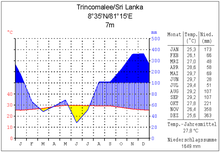
Climate diagram Trincomalee
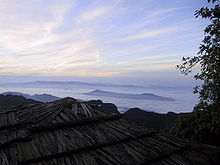
Sri Pada

Climate diagram Colombo
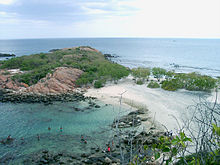
Pigeon Island (Trincomalee)

Topography
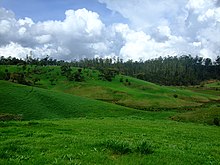
Hilly grassland in Nuwara Eliya
Administrative division
Sri Lanka is administratively divided into nine provinces and 25 districts. Each province is administered by a directly elected provincial council:
| # | Province | Capital | Districts | Area | Population2017 |
| 1 | Central Province | Kandy | Kandy, Matale, Nuwara Eliya | 05.674 | 2.722.000 |
| 2 | North Central Province | Anuradhapura | Anuradhapura, Polonnaruwa | 10.472 | 1.349.000 |
| 3 | Northern Province | Jaffna | Jaffna, Kilinochchi, Mannar, Vavuniya, Mullaitivu | 08.884 | 1.119.000 |
| 4 | Eastern Province | Trincomalee | Ampara, Batticaloa, Trincomalee | 09.996 | 1.677.000 |
| 5 | North West Province | Kurunegala | Kurunegala, Puttalam | 07.888 | 2.508.000 |
| 6 | Southern Province | Bile | Galle, Hambantota, Matara | 05.544 | 2.611.000 |
| 7 | Uva | Badulla | Badulla, Monaragala | 08.500 | 1.349.000 |
| 8 | Sabaragamuwa | Ratnapura | Kegalle, Ratnapura | 04.968 | 2.028.000 |
| 9 | Western Province | Colombo | Colombo, Gampaha, Kalutara | 03.684 | 6.081.000 |
From 1987 to 2007, the Northern and Eastern Provinces were united to form the Northeastern Province. However, the unification was declared invalid by the Supreme Court in 2006, so that the province was separated into the original provinces again as of 2007.
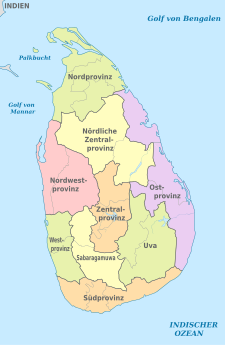
Provinces of Sri Lanka
Questions and Answers
Q: What is Sri Lanka?
A: Sri Lanka is a tropical island nation off the southeast coast of the Indian subcontinent.
Q: What is the capital of Sri Lanka?
A: The capital of Sri Lanka is Sri Jayawardenepura Kotte.
Q: What is the largest city in Sri Lanka?
A: The largest city in Sri Lanka is Colombo.
Q: What was Sri Lanka known as before 1972?
A: Sri Lanka was known as Ceylon before 1972.
Q: What were some other names that Sri Lanka was known as in the past?
A: Sri Lanka was also known as Serendib and Sinhale, among other names, before it was named Sri Lanka.
Q: What is the official language of Sri Lanka?
A: Tamil and Sinhala are the official languages of Sri Lanka.
Q: What is the significance of Sri Lanka in terms of democracy?
A: Sri Lanka holds the distinction of being South Asia's oldest democracy.
Search within the encyclopedia
